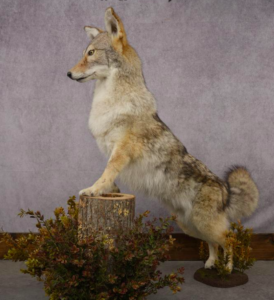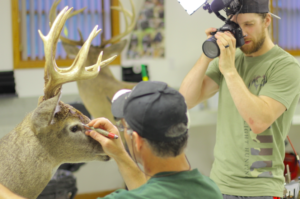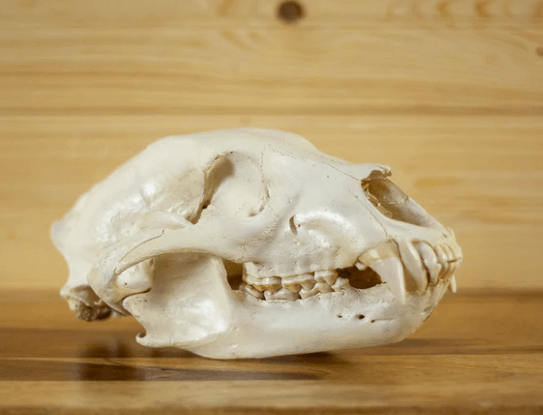
Bear Skull Taxidermy
Taxidermy is a complex art form that combines science, aesthetics, and a reverence for nature’s wonders. Consider the allure of a bear skull that has been expertly cleaned, conserved, and converted into a timeless masterpiece. The precise shapes and characteristics of a bear’s cranium are brought to life once again with delicate brushstrokes and sculpted accuracy, encouraging us to discover the wonders of the animal realm in a new and artistic way.
The act of conserving and exhibiting animal remains has grown into an art form in the field of taxidermy, bridging the gap between science and aesthetics. Bear skull taxidermy is a monument to the fundamental relationship that exists between human ingenuity and the natural world.
Welcome to the captivating world of “Crafting Elegance from Nature: The Art of Bear Skull Taxidermy.”
Bear hunting is a popular sports in Alaska, New York, Arkansas,
How to prepare a bear skull
Cleaning and conserving a bear skull correctly ensures its lifespan, safety, and usefulness for educational, scientific, or ornamental purposes. Here is a general guide on preparing a bear skull:
Materials Needed:
- Disposable gloves
- Utility knife or scalpel
- Small brushes
- Soft-bristle toothbrush
- Tweezers
- Mild dish soap
- Water
- Maceration container (if needed)
- Dermestid beetle colony (if available)
- Hydrogen peroxide (for whitening, if desired)
- Sealant (optional)
- Ventilated workspace
Steps:
Safety Precautions:
Protect your hands from potentially hazardous microorganisms or chemicals by using disposable gloves.
Remove Soft Tissues:
If there is any leftover flesh or tissue on the skull, gently remove it with a utility knife or scalpel. Take care not to injure the bones.
Brushing and Cleaning:
Remove dirt, debris, and any remnant tissue from the surfaces of the skull with tiny brushes and a soft-bristle toothbrush. Make sure you don’t scrape the bone.
Soap and Water Wash:
Fill a jar halfway with warm water and a tiny bit of mild dish soap. Scrub the skull gently with a brush or toothbrush to fully clean the bones. To eliminate soap residues, rinse the skull with clean water.
Maceration is optional.
If the skull still has recalcitrant tissue attached, maceration can be performed. Place the skull in a jar of water and immerse it for many days to weeks. The water will aid in the decomposition of the tissue. Change the water on a regular basis.
Optional Dermestid Beetles:
If you have access to a dermestid beetle colony, you can deposit the skull in one of the colony’s containers. Dermestid beetles devour flesh naturally, leaving the bones untouched. Patience and time are required for this procedure.
Rinse and Dry:
Rinse the skull well with clear water after maceration or beetle cleaning to eliminate any leftover material. Allow the skull to dry naturally in a well-ventilated environment.
Optional whitening:
If you want the skull to seem whiter, soak it in a solution of hydrogen peroxide and water. This can help brighten the colour of the bones. To avoid over-bleaching, keep a tight eye on the situation.
Optional sealant:
You may use a transparent sealer, such as a matte or glossy varnish, to preserve the skull and give it a polished appearance. Follow the manufacturer’s recommendations and allow for adequate drying time.
Displaying or storing:
Once the skull has been thoroughly cleaned and prepped, it can be used for educational purposes, scientific research, or ornament. To avoid degradation, keep it in a dry, dust-free environment.
It is crucial to be aware of local rules and ethical issues while handling animal remains, particularly skulls.
Best Bear Skulls for the money
1. Nice Medium-sized Black Bear Skull

Price….$429
The Black bear skull has been properly cleaned and has a lovely white colour. The mandible and skull have been fused. The skull contains all of its teeth. This skull, rated Nice for its obvious painting, is guaranteed to be a talking piece amid a collection of skulls or as an accent to your outdoorsy décor.
- Product Rating: Nice
- Dimensions: 11″ long X 6″ wide X 5.25″ tall
- Sits on its own on any sufficiently-sized horizontal surface
- Free Shipping in the Continental U.S.
- Check your state & local laws before purchasing. Black bear parts are illegal in many states.
2- Premier Brown Bear Skull
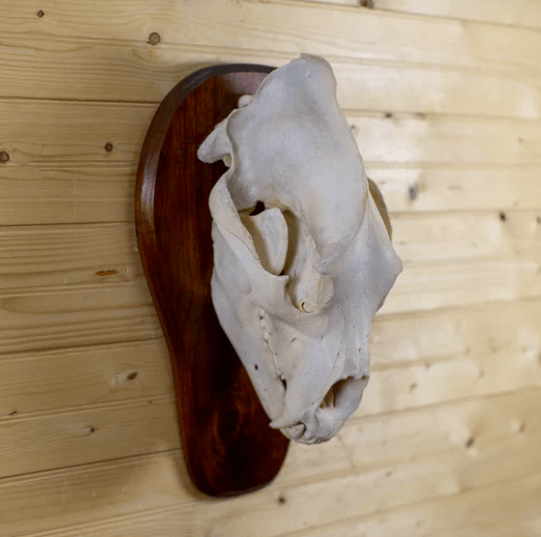
The skull has been properly cleaned and has a lovely white colour. The jaw and skull have been bonded together and a magnificent walnut plaque has been put on top. The skull contains all of its teeth. This Premier-quality skull is likely to be a talking piece amid a collection of skulls or as an addition to your outdoorsy décor, thanks to its size and outstanding preservation.
All required documentation is supplied.
- Product Rating: Premier
- Approximate Mount Dimensions: 20″ long/tall X 8.25″ deep X 11″ wide
- Sits on its own on any sufficiently-sized horizontal surface or hangs from a single screw.
- Free Shipping in the Continental U.S.
- Check your state & local laws before purchasing. bear parts are illegal in many states.
3. Brown Bear Full Skull For Sale
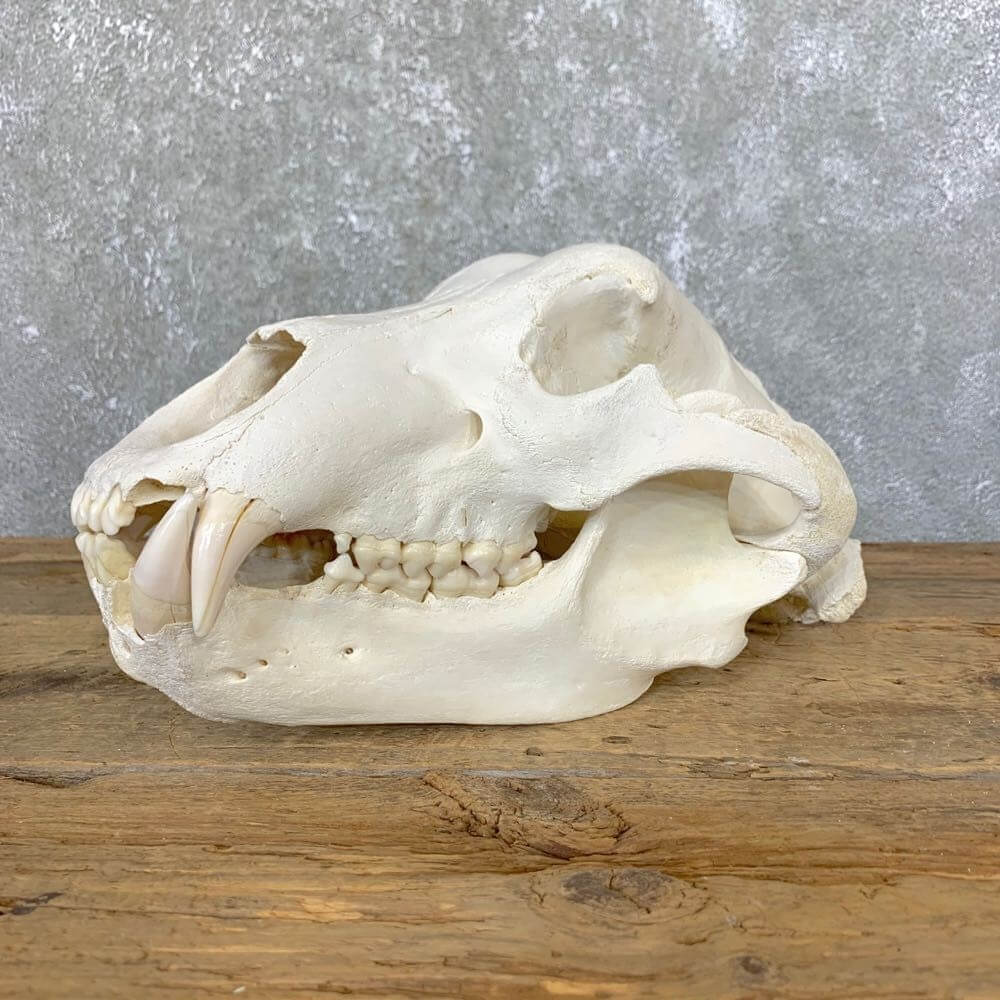
Full skull of an Alaskan Brown Bear. To provide a pleasant viewing experience, this skull has been carefully cleaned and whitened. This skull is in fantastic shape, with no missing teeth and a beautifully whitened and cleaned cranium. This large skull is 15 5/8″ in length and 8 7/8″ in breadth. All relevant measures and dimensions are supplied in the specs section to assist guarantee that this item will fit inside your planned location and match your expectations for the item’s featured attribute sizes, scores, and so on.
- Ideal for displaying on a shelf or mantle.
- Thoroughly cleaned and whitened by a professional.
4- Alaskan Grizzly Bear Full Skull For Sale
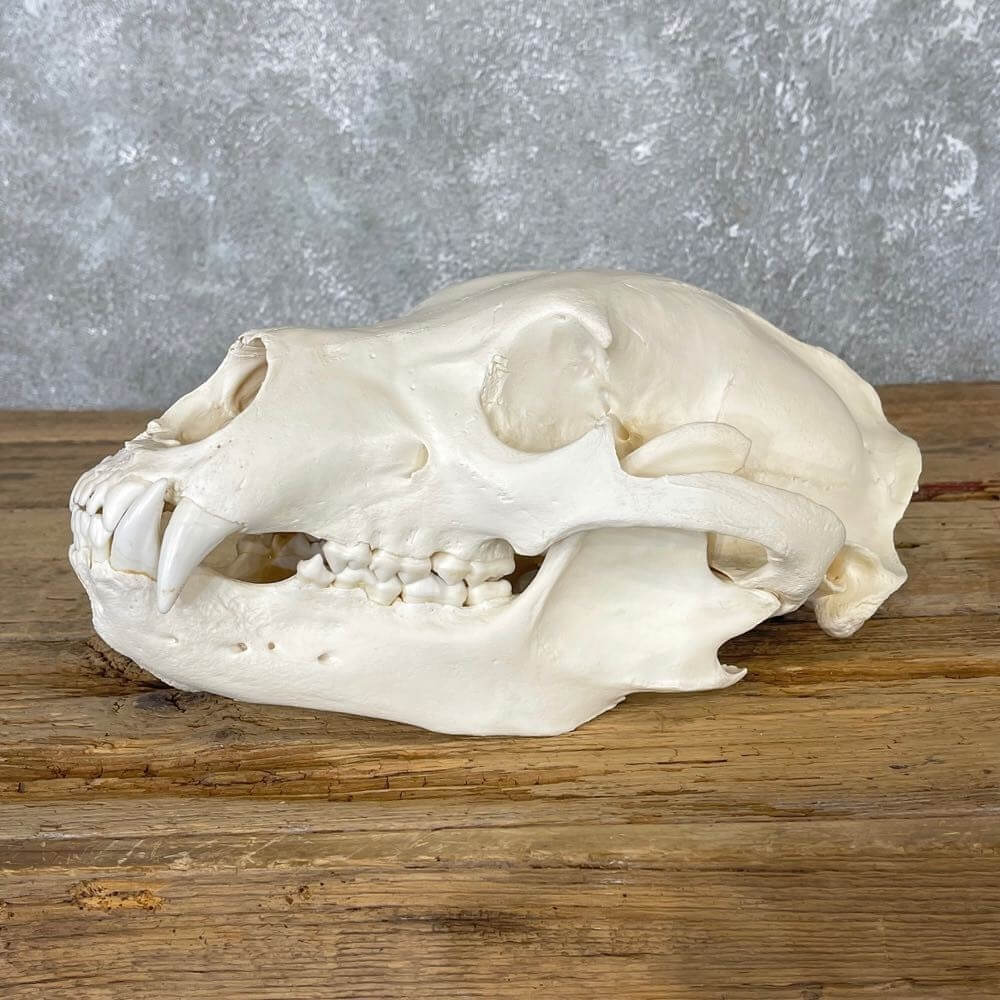
Full skull mount of an Alaskan Grizzly Bear. This skull has been thoroughly cleaned and whitened to enhance its beauty. The skull is 8 2/16″ in breadth and 14″ in length, earning it a Bronze Medal from the Safari Club International with a score of 22 2/16″.
This is an excellent addition to any collection! All relevant measures and dimensions are supplied in the specs section to assist guarantee that this item will fit inside your planned location and match your expectations for the item’s featured attribute sizes, scores, and so on.
- Ideal for placing on a shelf or mantle.
- This Alaskan Grizzly Bear has scored more than the Safari Club International Bronze Medal trophy book criteria.
5-Grizzly Bear Full Skull For Sale
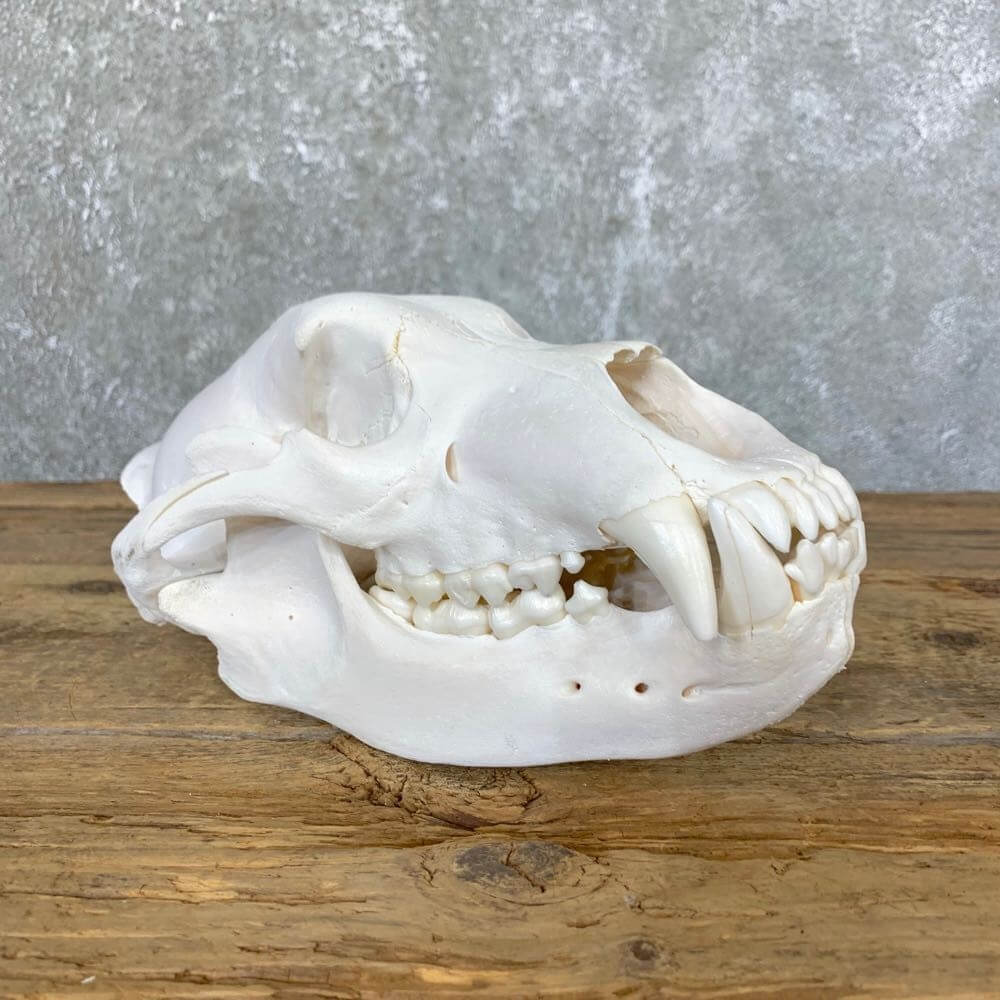
For sale is a magnificent Alaskan Grizzly Skull mount that has been properly cleaned and whitened. This item is virtually pristine and would look great in any collection! This skull is 12 2/8″ long and 6 6/8″ wide, for a total score of 19 0/8″.
If you’re seeking for a stunning skull for your collection, you’ve just found it! All relevant measures and dimensions are supplied in the specs section to assist guarantee that this item will fit inside your planned location and match your expectations for the item’s featured attribute sizes, scores, and so on.
- Ideal for displaying on a shelf or mantle.
How do you measure a bear’s skull?
Measuring a bear skull entails obtaining several parameters in order to acquire information about its size, proportions, and prospective traits. Here is a general approach to measuring a bear skull:
Materials Required:
- Callipers (analogue or digital)
- Ruler or measuring tape
- A pen and paper or a digital note-taking device is recommended.
- Bear Skull for measurement
Steps:
Select Reference Points:
Decide on the precise measurements you wish to measure before you begin. Skull length, breadth, height, and numerous cranial characteristics are all common measures.
Preparation of the Skull:
Make sure the bear skull is clean and clear of dirt and tissue. Handle the skull with caution and gloves if required to avoid infection or injury.
Skull Positioning:
Place the skull on a firm, level surface. Place it such that the reference locations you’re measuring are visible and easily accessible.
Measuring Length:
From the tip of the snout (nasal area) to the rear of the skull (occipital region), measure the overall length of the skull. This offers an overall measurement of the size of the skull.
Measuring Height:
Take the breadth of the skull at its widest point. A lateral measurement is commonly obtained across the zygomatic arches (cheekbones).
Height measurement:
The height of the skull is typically measured from the bottom of the lower jaw to the top of the skull. This indicates the vertical size of the skull.
Specific Cranial Features Measuring:
Specific traits such as the length and width of the cranial crest, the size of the orbits (eye sockets), and the length of the canines may be measured depending on your study or interest.
Recording Measurements:
Record each measurement precisely with your callipers, measuring tape, or ruler. Take careful notes on each measurement, identifying the reference locations you utilised.
Photographic documentation:
Take clean images of the skull from different angles. These photographs can be used as visual references to go along with your measurements.
Compare and Analyze:
Once you’ve recorded all of the measurements, you may compare them to those from other specimens or to data from scientific literature.
Keep in mind that uniformity in measuring procedure is critical for precise results. If you’re measuring for scientific or research reasons, you should check relevant scientific literature or specialists in the subject to verify you’re using proper reference points and measurement methodologies.
FAQs About Bear Skull
What is the significance of a bear skull?
Researchers, educators, and bear lovers may be interested in a bear skull because of its relevance in learning bear anatomy, behaviour, and evolution. It reveals information about a bear’s food, environment, and overall biology.
What can you learn from a bear skull?
Scientists can detect the species, age, sex, and health of a bear by analysing its skull. They can also investigate dental wear patterns to learn about people’s eating habits and preferences.
How can you determine the species of bear based on its skull?
The size, form, and distinctive features of the skull are frequently used to identify species. Bear species may be distinguished by characteristics such as the size of the cranial crest, snout length, and dental formula (the number and kinds of teeth).
What are some unique features of a bear skull?
Bear skulls feature powerful jaws and massive canine teeth that are ideal for omnivorous eating. The shape and size of these features vary between species and can reveal information about their behaviour and ecological niche.
How do researchers study bear skulls?
Researchers employ a variety of techniques, such as measuring skull size, checking teeth, and analysing bone density. These investigations will aid them in understanding the bear’s growth trends, mortality age, and population dynamics.
Are there differences between male and female bear skulls?
Yes, male and female bear skulls are typically different. Size, form, and features connected to secondary sexual traits, such as cranial crests, are examples of these distinctions. These characteristics aid researchers in determining the gender of a certain bear.
Where can I find bear skulls for educational purposes?
Bear skulls used for teaching purposes are frequently found at museums, educational institutions, and research centres that specialise in animal biology or anatomy. There are other internet stores where replica bear skulls may be ordered for instructional purposes.
Are bear skulls legally protected?
Bear species are protected by wildlife protection regulations in several areas. This protection includes their remains, especially their heads. It is critical to understand the laws governing the ownership, sale, and transit of bear skulls and other animal remains.
Can you tell the age of a bear by its skull?
By studying a bear’s skull, scientists can determine its age at death. The patterns of growth in cranial sutures and dental development assist establish whether the bear died as a juvenile, subadult, or adult.
Do bear skulls reveal anything about their behaviour?
Yes, based on tooth wear patterns and jaw shape, bear skulls can reveal information about a bear’s dietary habits. Furthermore, characteristics like as cranial crests and muscle attachment sites might provide information on their behaviour, such as dominance and social interactions.
What function do a bear’s teeth serve in its skull?
A bear’s teeth are essential for survival. They have evolved to eat an omnivorous diet of plant materials, fruits, insects, and occasionally meat. The molars are utilised for crushing plant material, but the canines are employed for grabbing, tearing, and hunting.
Can you determine a bear’s health from its skull?
Yes, the state of a bear’s skull can reveal information about its general health. Abnormalities or evidence of illness, such as bone development abnormalities or signs of trauma, may be apparent in the bone structure of the skull.
How do bear skulls differ across species?
Based on their surroundings and nutritional choices, different bear species have evolved distinct adaptations. Polar bear skulls, for example, are evolved for hunting seals in watery habitats, but grizzly bear skulls are adapted for scavenging and eating a range of foods.
What steps are involved in cleaning and preserving a bear skull?
Cleaning and maintaining a bear skull entails removing soft parts like flesh and cartilage by maceration or dermestid beetle colonies. After washing, thoroughly bleach the skull to whiten the bones. To avoid degradation, preserving may entail applying a protective sealant.
Are there any cultural or spiritual associations with bear skulls?
Bear skulls possess cultural and spiritual importance in several indigenous civilizations. They might be utilised in rituals, storytelling, or as symbols of power, knowledge, or connectedness to the natural world.
Can you estimate a bear’s size from its skull?
While skull dimensions can offer some idea of a bear’s size, they are not usually accurate measurements. Skull size can vary depending to factors such as age, gender, and health. However, the overall size of the skull can provide a broad notion of the bear’s size category (e.g., adult vs. adolescent).
Do bear skulls change as they age?
Yes, bear skulls alter as the bear gets older. Juvenile skulls differ from adult skulls in several ways, including the existence of deciduous (baby) teeth. Bears’ skulls undergo fusion of some bones and changes in dental wear as they develop.
Are there any online resources for studying bear skulls?
Scientific articles, instructional websites, and virtual collections from museums and research institutes are among the online resources that give information about bear skulls. These resources can provide thorough information about bear anatomy and behaviour.
Related

